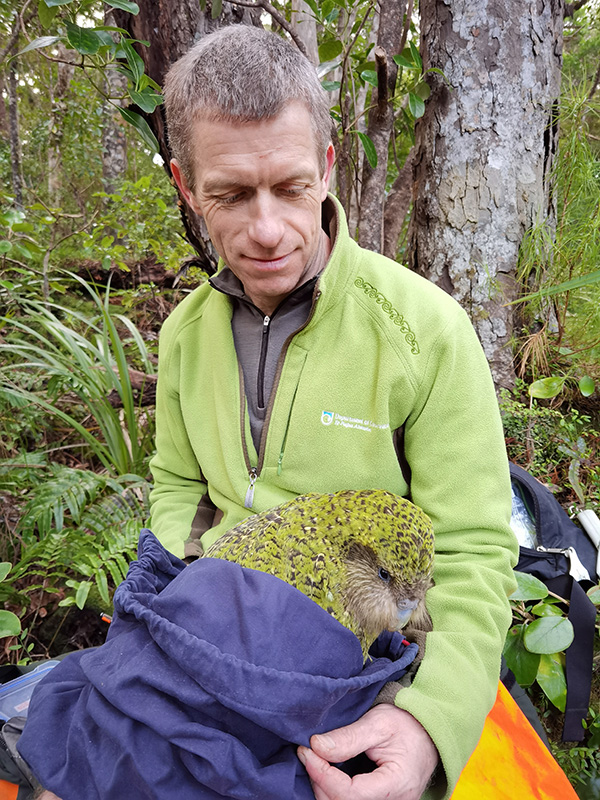New Zealand’s quest to save its rotund, flightless parrots
DNA sequencing, GPS tracking and tailored diets are slowly restoring the endangered kākāpō
Support sound science and smart stories
Help us make scientific knowledge accessible to all
Donate today
Kākāpō are avid walkers, wandering on strong legs for miles at a time and hiking up mountains to find mates. They’re keen climbers too, clambering up New Zealand’s 65-foot-high rimu trees on large claws to forage for red berries on the tips of the conifer’s branches.
But there’s one thing that the world’s heaviest parrot species can’t do: fly. With their bulky frames — males weigh up to nine pounds — and waddling gait, they have little chance of outrunning predators like stoats and feral cats. When threatened, the nocturnal parrots freeze, relying on their moss-green feathers to act as camouflage.
New Zealand was once a land of flightless birds like the extinct moa — no terrestrial mammalian predators in sight. That changed in the 13th century, when Māori voyagers brought rats and dogs, and again in the 19th century, when European settlers brought more rats, cats and mustelids like weasels, stoats and ferrets. These predators have played a major role in putting at risk some 300 native species on New Zealand’s two main islands and smaller offshore islands, taking an especially heavy toll on flightless birds like kākāpō.
Now listed as critically endangered, the kākāpō teetered on the edge of extinction in the mid-1900s due to hunting, predators and land clearance. From the 1970s, conservation efforts focused on managing the remaining kākāpō on the country’s offshore islands, where predators are systematically eradicated. Due to those ongoing efforts, which include breeding programs, veterinary treatment and supplementary food, parrot numbers have grown from fewer than 60 in 1995 to more than 200 today.
That success, plus lack of space in offshore islands, led New Zealand’s Department of Conservation and Ngāi Tahu, the Māori tribe whose people serve as traditional guardians of the kākāpō, to find a new habitat for the parrots. Starting in July 2023, relocations began to the 8,400-acre Sanctuary Mountain Maungatautari, a predator-free haven enclosed by one of the world’s longest pest-proof fences.
So far, 10 male parrots have moved to the reserve — the first time the species is living back on the mainland in almost half a century. Researchers are tracking their locations and conducting regular health checkups to assess whether the birds can thrive there.
If male parrots start hiking to the ridgetops, serenading female kākāpō with deep “booms” and high-pitched “chings,” they might be in shape to breed, says conservation biologist Andrew Digby, science advisor for kākāpō at the Department of Conservation. “We might start looking at bringing females in.”

After nearly a decade of working with kākāpō, Andrew Digby says he’s still surprised by the parrots’ individual personalities.
CREDIT: LYDIA UDDSTROM FOR NEW ZEALAND’S DEPARTMENT OF CONSERVATION (DOC)
Kākāpō have much lower fertility than other parrots. Since the 1980s, fewer than half their eggs have hatched, which is thought to be partly due to inbreeding. Left to their own devices, they breed only when rimu trees bear masses of fruit, every two to four years, with females laying one to four eggs.
Recently, researchers have started to explore how genomic data can contribute to kākāpō survival. Such studies can help wildlife managers boost genetic diversity and resilience in threatened species, says evolutionary biologist Cynthia Steiner of the San Diego Zoo Wildlife Alliance.
In one important study published in 2023, researchers analyzed whole-genome sequence data for 169 parrots — nearly all of those living when the research began in 2018. That work yielded crucial insights, including genetic variations affecting aspects of kākāpō chick development, like height and growth rate. This could help scientists predict how quickly baby birds will grow, and initiate veterinary interventions should the growth rates deviate, says Joseph Guhlin, a genomicist with Genomics Aotearoa at the University of Otago in Dunedin, New Zealand.
Scientists also found that some kākāpō have genetic resistance to aspergillosis, a fungal respiratory disease. In 2019, an outbreak affected 21 birds and killed nine. If another outbreak occurs, vulnerable parrots could be isolated and treated ahead of time, Guhlin says.
As of October 2023, all parrots in the sanctuary were doing well, although the first four arrivals lost a bit of weight. Thanks to GPS trackers attached to each bird, “we can see that they’ve been bouncing around all over the place,” Digby says. But the survival of kākāpō beyond fenced-in sanctuaries depends on the success of Predator Free 2050, an ambitious initiative to eradicate some of the introduced predators most harmful to New Zealand’s native wildlife by 2050.
“Eradications are a high-cost, high-risk, high-reward strategy,” says ecologist Stephen Hartley of Te Herenga Waka-Victoria University of Wellington. Hartley thinks it may be possible to get rid of possums, because they breed slowly and are easy to detect, but that rats and mustelids will be nearly impossible to eliminate without introducing some form of genetic or biological control, such as gene editing or introducing a parasite to prevent them from reproducing.
If all goes as planned, people across New Zealand may one day be able to see and hear the parrots from their own backyards. For now, they can traipse through the forest sanctuary the parrots now call home. “Transferring them to Maungatautari is a good first step,” Digby says. “It brings kākāpō back to where people are.”
10.1146/knowable-112823-2
TAKE A DEEPER DIVE | Explore Related Scholarly Articles




